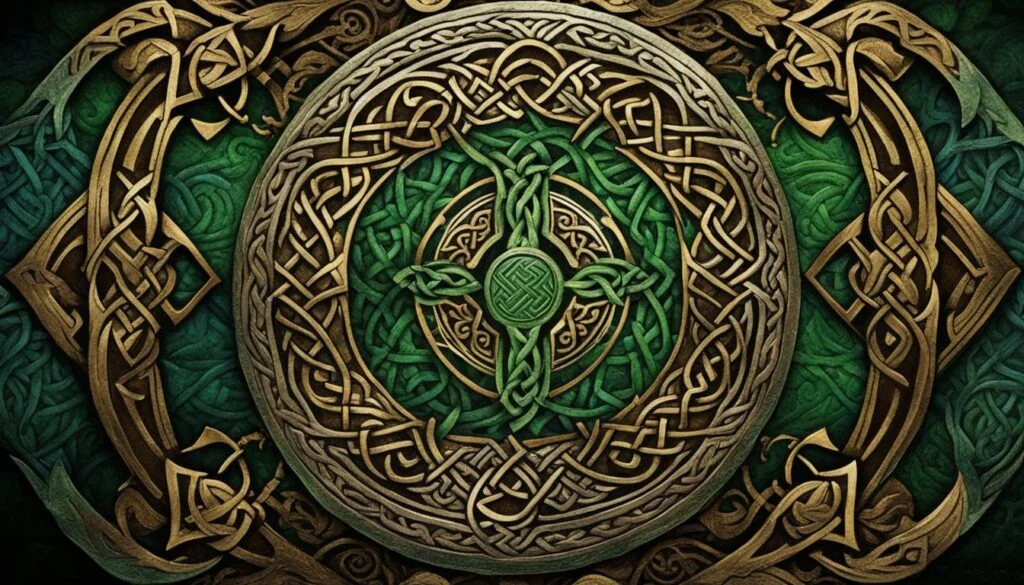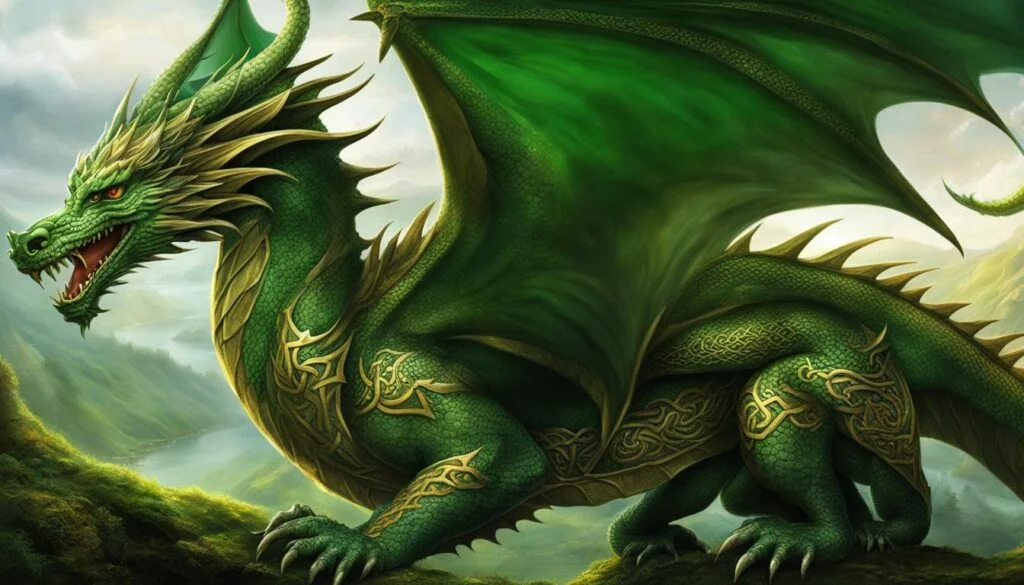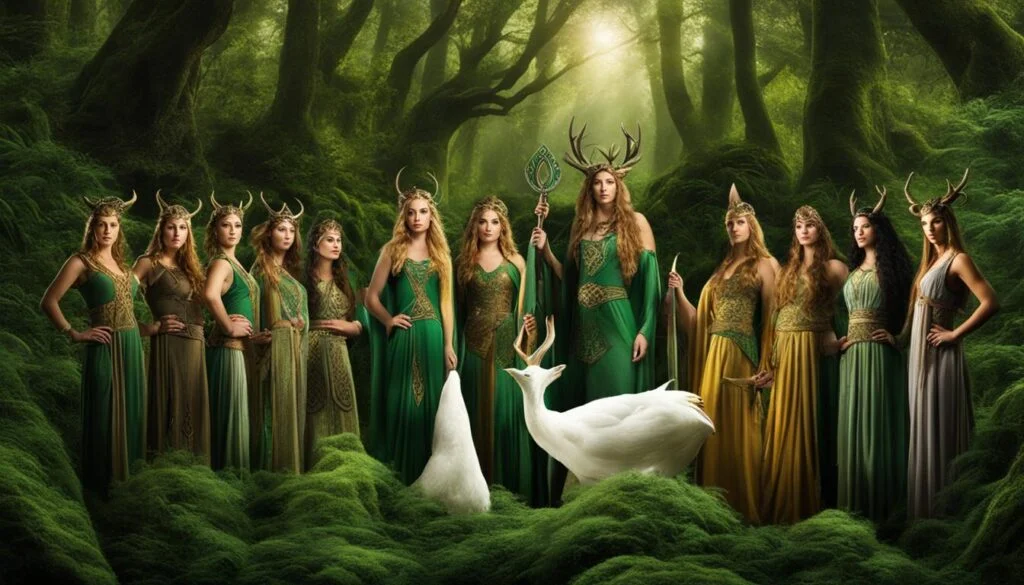Welcome to our exploration of Celtic and Norse mythology! These fascinating mythologies have captured the imagination of countless people throughout history. From epic tales of gods and goddesses to magical creatures and mystical realms, Celtic and Norse mythology offer a rich tapestry of stories and legends.
In this article, we will delve into the similarities and differences between Celtic and Norse mythology. While both mythologies share some common threads, they also have distinct origins, beliefs, and cultural influences. Join us as we uncover the unique characteristics of these ancient mythological traditions.
Key Takeaways:
- Both Celtic and Norse mythologies are rich in exciting plots and captivating characters.
- Celtic mythology originated with the Celts of Central Europe, while Norse mythology originated with the Northern Germanic people.
- Both mythologies feature a pantheon of gods and goddesses, but the specific deities worshipped differ between the two.
- The Celtic and Norse belief systems are polytheistic, emphasizing the power and interconnectedness of the natural world.
- Celtic and Norse mythologies have distinct storytelling traditions and artistic influences.
Norse Mythology vs Celtic Mythology – A Comparison
When it comes to comparing Norse and Celtic mythology, it’s fascinating to explore the similarities and differences between these two ancient mythological traditions. Both Norse and Celtic mythologies have their unique origins, narration, and religious beliefs, making them distinct and captivating in their own right.
In terms of origin, Norse mythology stems from the Northern Germanic people, while Celtic mythology finds its roots in the Celts of Central Europe. This distinction in cultural origins lays the foundation for the contrasting beliefs and stories found in each mythology. Norse mythology is known for its grand narratives documented in Scandinavian manuscripts, whereas Celtic mythology is primarily passed down through oral folklore and a few Gaulish writings.
Key Differences Between Norse and Celtic Mythologies:
- Origins: Norse mythology originates from Northern Germanic people, while Celtic mythology stems from the Celts of Central Europe.
- Narration: Norse mythology is primarily documented in Scandinavian manuscripts, whereas Celtic mythology is passed down through oral folklore and a few written records.
- Religious Beliefs: Both mythologies are polytheistic, but their pantheons and deities differ. The Celtic pantheon includes gods such as Dagda, Morrigan, and Lugh, while the Norse pantheon features Odin, Thor, Loki, and Freya.
- Famous Features: Norse mythology is known for Yggdrasil, the world tree, and the apocalyptic event of Ragnarok. Celtic mythology features the concept of the Otherworld and the belief in the three-fold death.
- Artistic Influences: Celtic art showcases intricate circular patterns and spirals, while Norse art is characterized by complex decorative patterns often featuring animals.
By exploring the differences and similarities between Norse and Celtic mythologies, we gain a deeper understanding and appreciation for the cultural heritage of both traditions. These mythologies have captivated generations with their enchanting stories, epic battles, and divine beings. As we delve further into the realms of Norse and Celtic mythologies, we uncover a tapestry of distinct beliefs, folklore, and legends that continue to inspire and intrigue us today.
Origin and Narration of Mythology
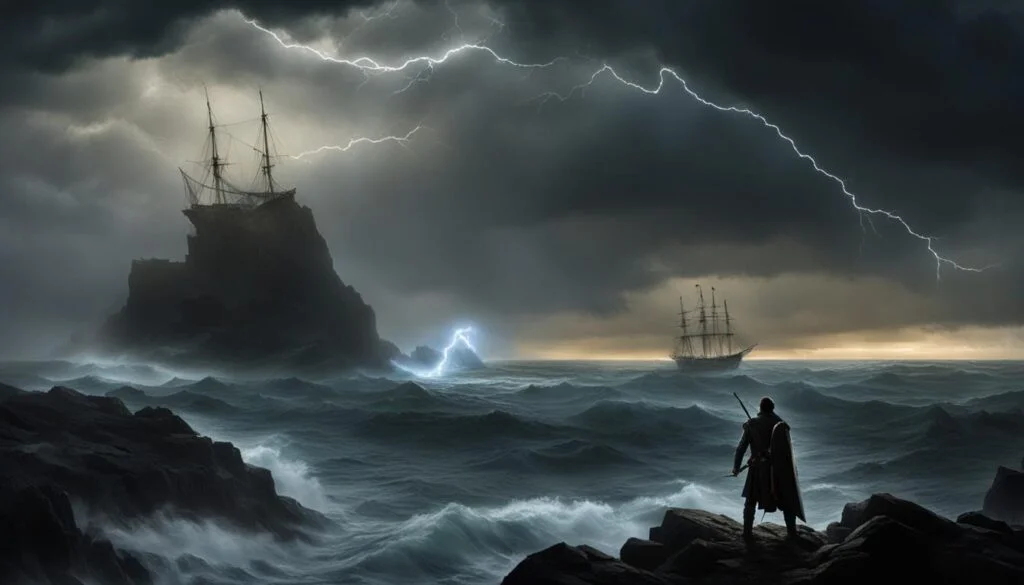
Understanding the origin and narration of Celtic and Norse mythology is key to appreciating their unique characteristics and cultural significance. Celtic mythology, with its roots in the Celts of Central Europe, has a rich heritage passed down through generations via oral folklore and a handful of Gaulish writings. This oral tradition adds an element of mystique and allows for storytelling to evolve over time, capturing the essence of Celtic beliefs and customs.
On the other hand, Norse mythology finds its origins in the Germanic tribes of Northern Europe. It is primarily documented through Scandinavian manuscripts, which provide detailed accounts of the gods, goddesses, and mythical tales that form the foundation of Norse mythology. Written texts have helped preserve and shape the intricate narrative of Norse mythology, offering a deeper understanding of the gods, their interactions, and the cosmology of the Norse world.
Narration of Celtic Mythology:
- Passed down through generations via oral folklore
- Limited written records with a few Gaulish writings
- Evolutionary storytelling, capturing the essence of Celtic beliefs and customs
Narration of Norse Mythology:
- Documented in Scandinavian manuscripts
- Detailed accounts of gods, goddesses, and mythical tales
- Preservation and shaping of mythology through written texts
The distinct origins and modes of narration contribute to the differences between Celtic and Norse mythology, shaping their respective mythological landscapes and providing a glimpse into the ancient cultures that brought these captivating tales to life.
Religion and Beliefs
Religion and beliefs play a vital role in shaping the mythologies of both the Celtic and Norse cultures. In Celtic mythology, the gods and goddesses are deeply intertwined with the natural world and are often associated with specific natural elements or phenomena. The Celts believed in the concept of animism, where natural objects and places, such as trees, rivers, and mountains, were considered to have spirits or divine essence. This reverence for nature and its connection to the spiritual realm is a core aspect of Celtic beliefs.
In Norse mythology, the gods and goddesses hold great power and influence over various aspects of life, including war, fertility, and wisdom. These gods and goddesses are part of a complex cosmology that encompasses the Nine Worlds, each with its own distinct characteristics and inhabitants. The Norse people believed in fate and destiny, with the concept of Ragnarok, the end of the world, playing a significant role in their beliefs. The gods and goddesses in Norse mythology are seen as both protectors and challengers of humanity, reflecting the complex and dynamic nature of their religious beliefs.
Both Celtic and Norse mythologies are polytheistic, meaning they believe in multiple gods and goddesses. The Celtic pantheon includes deities such as the Dagda, the god of abundance and protector of the tribe, Morrigan, the goddess of battle and sovereignty, and Lugh, the god of skill and craftsmanship. In Norse mythology, Odin, the Allfather and ruler of the gods, Thor, the god of thunder and protector of humanity, Loki, the trickster god, and Freya, the goddess of love and beauty, are among the most prominent figures. The worship of these gods and goddesses was a central aspect of religious practices in both Celtic and Norse cultures, influencing rituals, festivals, and everyday life.
Key Points:
- Celtic mythology revolves around a deep connection with nature and the belief in animism.
- Norse mythology features gods and goddesses with specific roles and influences over different aspects of life.
- Both mythologies are polytheistic, with a pantheon of gods and goddesses worshipped by their respective cultures.
- Religious beliefs in Celtic and Norse mythologies shape the rituals, festivals, and everyday practices of the people.
Famous Features of Celtic and Norse Mythology
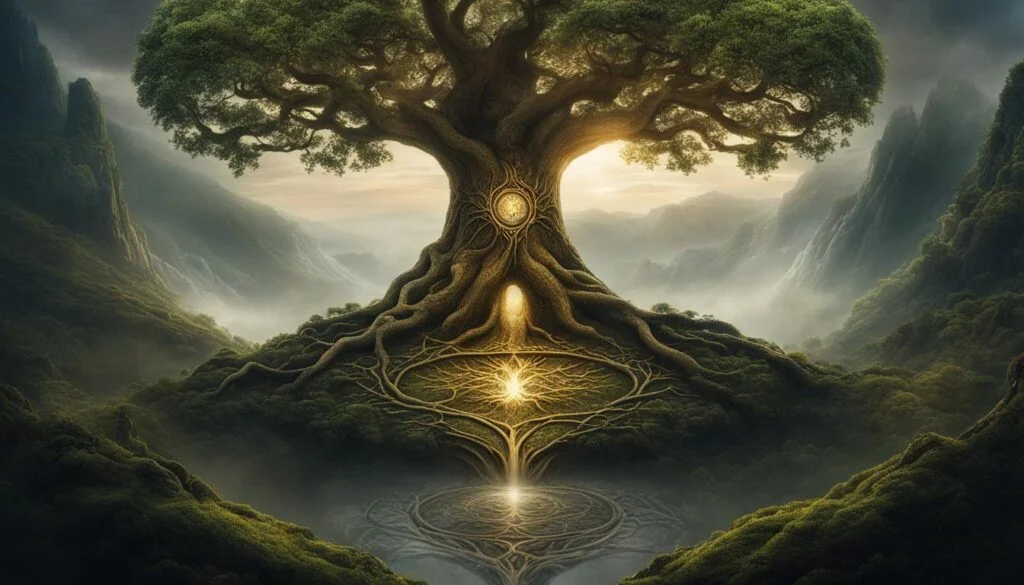
In the realm of mythology, both Celtic and Norse traditions are known for their fascinating and distinctive features. These features add depth and intrigue to the stories and legends that have captured our imaginations for centuries.
Yggdrasil: The World Tree of Norse Mythology
One of the most famous features of Norse mythology is Yggdrasil, the mighty World Tree that connects the nine realms of existence. Yggdrasil stands at the center of the Norse cosmos, with its branches extending into the heavens and its roots reaching deep into the underworld. This colossal tree serves as a symbol of the interconnectedness of all things and the cyclical nature of life.
The Otherworld: A Mystical Realm in Celtic Mythology
In Celtic mythology, the concept of the Otherworld holds great significance. It is a mystical realm that exists parallel to the physical world and is inhabited by supernatural beings, fairies, and gods. The Otherworld represents a place of magic and enchantment, where time stands still and mortal visitors often undergo transformative experiences. Exploring the Otherworld is a recurring theme in Celtic tales and poems, offering a glimpse into a realm beyond our own.
- Yggdrasil, the World Tree, symbolizes the interconnectedness of the Norse cosmos.
- The Otherworld in Celtic mythology is a mystical realm inhabited by supernatural beings.
The rich and diverse mythological features found in both Celtic and Norse traditions continue to captivate and inspire us today. Yggdrasil and the Otherworld are just a glimpse into the vast tapestry of gods, creatures, and realms that make up these ancient mythologies.
Important Gods and Goddesses
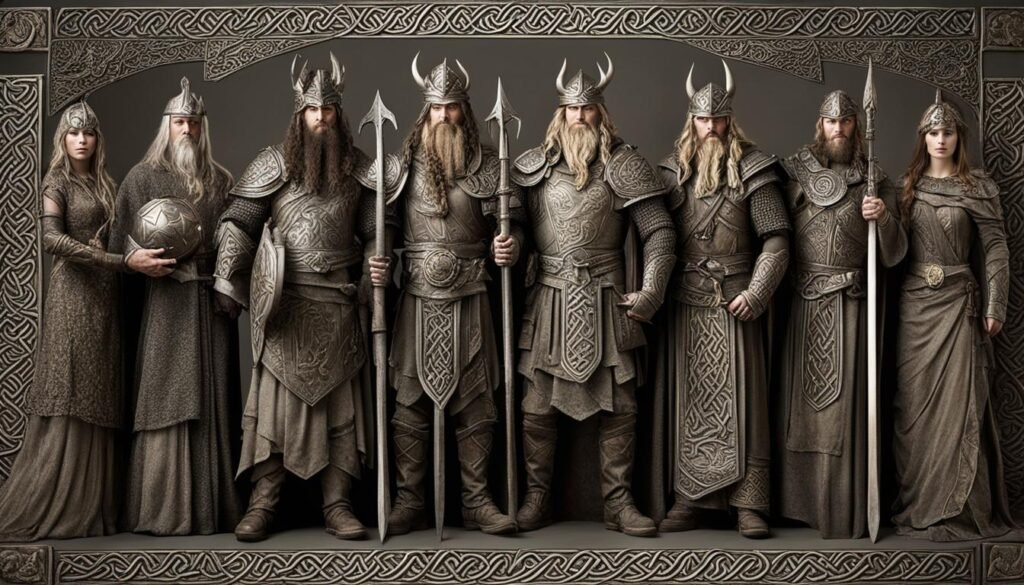
When exploring Celtic and Norse mythology, it is impossible not to be captivated by the powerful gods and goddesses that inhabit these ancient worlds. These deities play significant roles in shaping the narratives and beliefs of their respective cultures.
Important Gods of Celtic Mythology
- The Dagda: Known as the “Good God,” the Dagda is a central figure in Celtic mythology. He embodies strength, wisdom, and fertility, and is often associated with the harvest and abundance.
- Morrigan: The Morrigan is a goddess of war, sovereignty, and fate. She takes on different forms, often appearing as a crow or raven, and is both feared and revered for her power in battle.
- Lugh: Lugh is a multi-skilled god associated with craftsmanship, skill, and the arts. He is often depicted as a warrior and is known for his mastery in many domains.
Important Gods of Norse Mythology
- Odin: The chief deity of the Norse pantheon, Odin is the god of wisdom, knowledge, and war. He rules over Asgard, the realm of gods, and is associated with magic, prophecy, and poetry.
- Thor: Known for his mighty hammer Mjolnir, Thor is the god of thunder, lightning, and strength. He is a protector of both gods and humans and symbolizes bravery and courage.
- Loki: Loki is a complex trickster figure in Norse mythology. He possesses shapeshifting abilities and is both a friend and a foe to the gods. Loki’s mischievous nature often leads to chaos and disruption.
- Freya: Freya is the goddess of love, beauty, and fertility. She is associated with magic, sexuality, and wealth. Freya is also a powerful warrior and leader of the Valkyries.
These are just a few of the many gods and goddesses that populate the rich mythologies of the Celts and Norse. Each deity holds a unique place in their respective pantheons and embodies different aspects of human experience and nature. Their stories and worship provide valuable insights into the ancient cultures that revered them.
Similarities Between Celtic and Norse Mythology
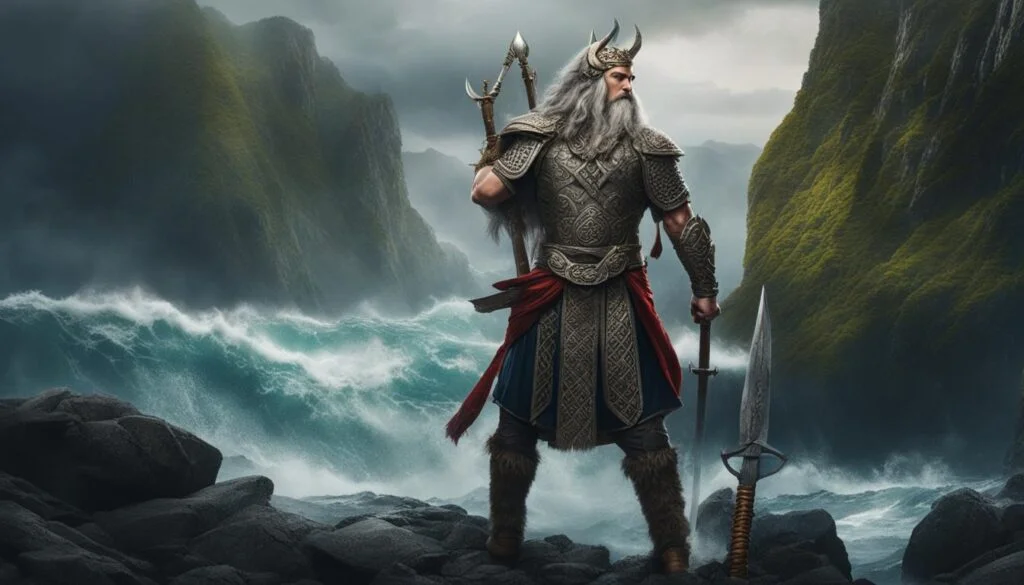
When exploring the fascinating realms of Celtic and Norse mythology, one cannot help but notice the intriguing similarities that exist between these two ancient mythological traditions. While they may originate from different cultures and regions, they share common themes and beliefs that reflect the universal human fascination with nature, gods, and storytelling.
Shared Polytheistic Beliefs
One of the notable similarities between Celtic and Norse mythology is their shared polytheistic nature. Both mythologies believe in the existence of multiple gods and goddesses who hold power and influence over various aspects of life. In Celtic mythology, deities such as the Dagda, Morrigan, and Lugh play pivotal roles, while Norse mythology features gods like Odin, Thor, Loki, and Freya. The presence of a pantheon of gods in both traditions highlights the importance placed on divine beings and their interactions with humans.
Connection to Nature
Another significant similarity between Celtic and Norse mythology is their deep connection to nature. Both mythologies emphasize the power and interconnectedness of the natural world. In Celtic mythology, concepts such as the Otherworld, where supernatural beings reside, and the belief in the three-fold death demonstrate the reverence for nature and its mystical elements. Similarly, in Norse mythology, the image of Yggdrasil, the world tree that connects the nine realms, symbolizes the interwoven nature of the cosmic order. This shared appreciation for nature enhances the storytelling and themes present in both mythologies.
Love for Oral Folklore
Both Celtic and Norse cultures exhibit a strong tradition of oral folklore, which has shaped and preserved their mythologies. The art of storytelling holds great importance in both traditions, with bards and skalds passing down tales from generation to generation. The reliance on oral tradition in Celtic and Norse cultures highlights the value placed on communal storytelling and the preservation of cultural heritage. The love for oral folklore has contributed to the richness and diversity of the stories and legends found in these mythologies.
In conclusion, while Celtic and Norse mythology have distinct origins and cultural backgrounds, they share compelling similarities that shed light on our shared human imagination and fascination with the divine, nature, and storytelling. The polytheistic beliefs, connection to nature, and love for oral folklore unite these mythological traditions and remind us of the universal themes that resonate across time and cultures.
Differences Between Celtic and Norse Mythology
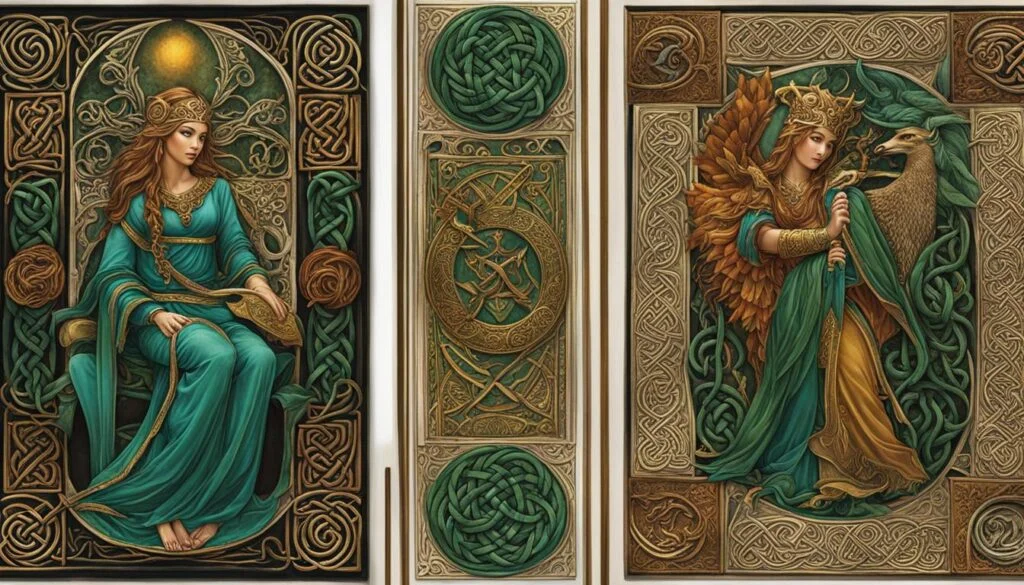
In exploring the fascinating realms of Celtic and Norse mythology, we come across distinct differences that make each mythology unique in its own right. Let’s delve into some of these differences:
1. Origins and Narration
Celtic mythology finds its roots in the Celts of Central Europe, with its stories primarily passed down through oral folklore and a few Gaulish writings. On the other hand, Norse mythology originates from the Northern Germanic people and is narrated through Scandinavian manuscripts. The contrasting origins and methods of narration contribute to the diverse storytelling traditions found within these mythologies.
2. Gods and Goddesses
When it comes to the pantheons, Celtic and Norse mythologies feature different gods and goddesses. In Celtic mythology, the Dagda, Morrigan, and Lugh are among the key deities, each associated with specific aspects of life. Norse mythology, on the other hand, centers around gods like Odin, Thor, Loki, and Freya, who hold dominion over different realms and embody distinct characteristics and abilities.
3. Cultural and Societal Influences
The cultural and societal characteristics of the Celts and Norse also contribute to the divergence of their mythologies. The Celts were known for their complex societies and rich traditions, which influenced the themes and narratives within Celtic mythology. The Norse, on the other hand, were shaped by their harsh environments and seafaring way of life, resulting in mythological tales that reflected their unique cultural experiences.
As we explore the differences between Celtic and Norse mythology, we gain a deeper appreciation for the diverse ways in which cultures have crafted their own mythological traditions. The contrasting origins, gods, and societal influences offer a glimpse into the rich tapestry of beliefs and stories that have shaped human history.
Viking and Celtic Connections

When exploring the realms of Norse and Celtic mythology, it’s impossible to ignore the historical connections between the Vikings and the Celts. These two ancient cultures had geographical proximity and interactions that influenced their mythologies and traditions. The Vikings, originally from Scandinavia, ventured out into various parts of Europe, including the British Isles, where they encountered the Celts. This interaction between the Vikings and the Celts shaped their cultures and left a lasting impact on their mythological narratives.
The Celts, known for their complex societies and rich traditions, had contact with the Vikings and shared some cultural and linguistic traits. Despite their differences, these ancient European cultures found common ground through trade, communication, and the exchange of ideas. The Vikings’ invasions and settlements in Celtic lands led to cultural intermingling, influencing their respective mythologies. The stories and legends shared between the Vikings and the Celts highlight the interconnectedness of ancient European cultures and demonstrate how myths and beliefs can evolve through cultural contact.
Shared Influences and Cultural Exchange
- The Vikings and the Celts exchanged both tangible and intangible goods, fostering a cultural exchange that impacted their mythologies.
- Language and communication played a crucial role in the Viking-Celtic connections, as both cultures had their unique languages and storytelling traditions.
- The Vikings’ artistic influences can be seen in Celtic art, with intricate patterns and motifs similar to those found in Norse art.
Intermingling of Mythological Themes
- The Viking and Celtic mythologies share common themes such as the belief in powerful gods and goddesses, the interconnectedness of nature, and epic tales of heroism.
- Some Celtic and Norse gods and goddesses bear similarities and may have been influenced by each other through the cultural exchange.
- Both mythologies contain stories of epic battles, mythical creatures, and supernatural realms, capturing the imagination and beliefs of their respective cultures.
The Viking and Celtic connections exemplify the vibrant and interconnected nature of ancient European cultures. The interactions between these cultures influenced their mythologies, art, language, and beliefs. Exploring the Viking and Celtic connections not only provides insight into the rich tapestry of European mythologies but also highlights the collective human experience of storytelling and cultural exchange.
Norse and Celtic Communication: Language and Exchange
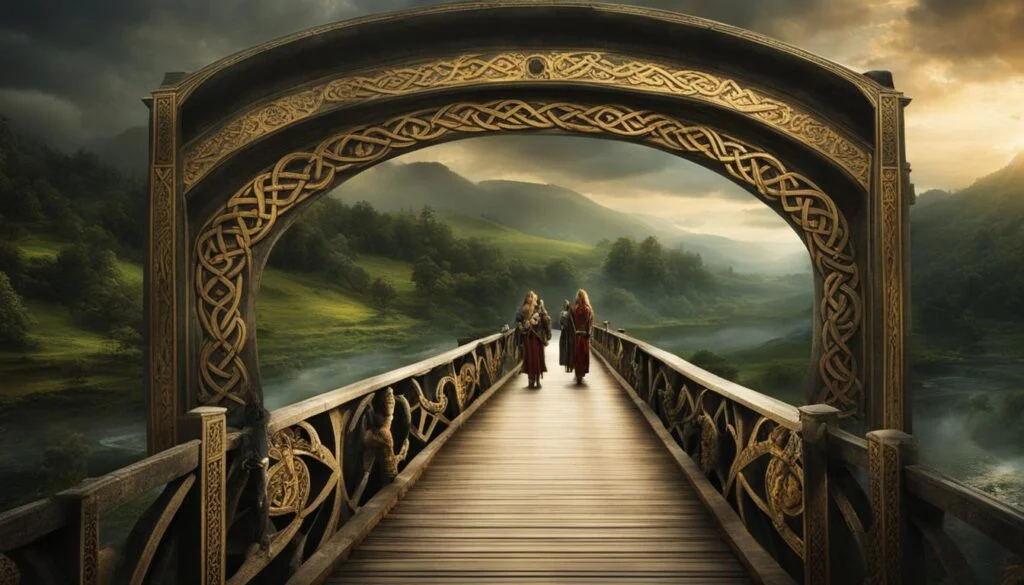
Language plays a significant role in shaping culture and facilitating communication. In the case of Norse and Celtic mythologies, their distinct languages, along with oral traditions, were instrumental in exchanging stories, beliefs, and cultural influences.
Celtic Language: A Rich Linguistic Heritage
The Celtic peoples had a diverse range of languages, including Irish, Welsh, and Scottish Gaelic. These Celtic languages belonged to the Indo-European language family and had their unique characteristics and dialects. Old Irish, in particular, emerged as the most prominent Celtic language and was widely used for communication and storytelling.
The oral nature of Celtic mythology allowed for the transmission of stories and legends in their original language, preserving the cultural nuances and traditional expressions that gave these myths their depth and richness.
Norse Language: The Power of Old Norse
The Norse people primarily spoke Old Norse, a North Germanic language that served as a medium for their mythological narratives. Old Norse was used in the recording of their sagas, poems, and mythological texts, providing us with valuable insights into their beliefs and cosmology.
The poetic and symbolic language of Old Norse revealed the Norse worldview and their unique understanding of the universe. It allowed for the effective expression of concepts and ideas that were central to their mythology, such as the complex relationship between gods, humans, and nature.
Communication and Cultural Exchange
Despite the linguistic differences between Celtic and Norse cultures, communication and cultural exchange were possible through oral storytelling and interactions among neighboring communities. Both cultures had a strong tradition of oral folklore, which served as a bridge between different linguistic communities and facilitated the sharing of tales, legends, and religious beliefs.
Through trade, conquests, and migrations, the Norse and Celtic peoples had opportunities to interact and influence each other’s mythologies. Cultural exchanges between the Vikings and Celts, for example, may have led to the adoption of certain mythological motifs, names of deities, and storytelling techniques.
Norse and Celtic Art: Influences and Unique Characteristics
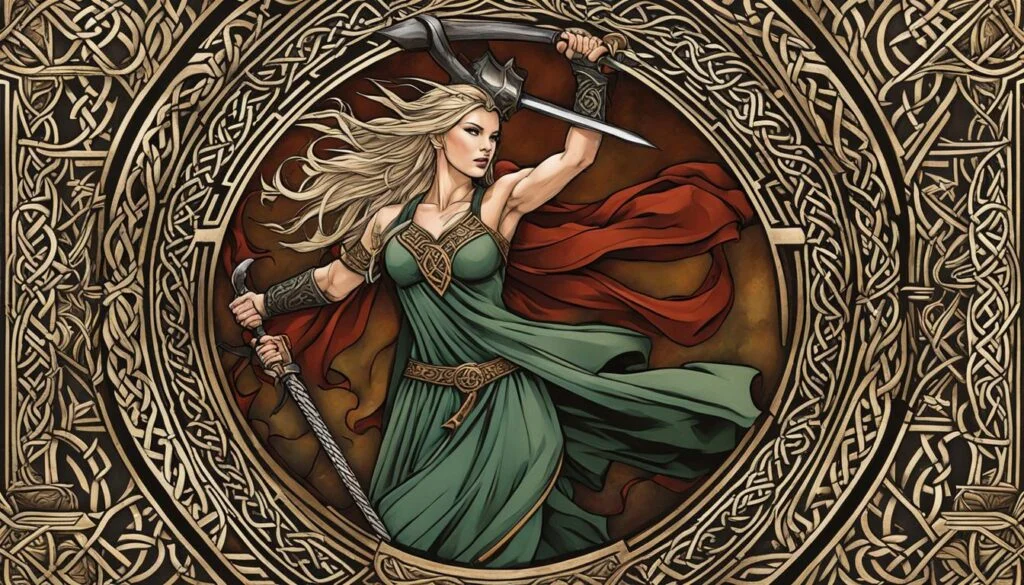
Celtic and Norse art are both renowned for their unique characteristics and significant influences on European artistic traditions. With intricate designs and skilled craftsmanship, these art forms showcase the creativity and cultural heritage of their respective cultures.
Celtic art is characterized by its intricate circular patterns and spirals, often adorned with floral motifs. This art form is widely recognized for its emphasis on symmetry and symbolism. Celtic art can be found in various mediums, including stone carvings, metalwork, illuminated manuscripts, and jewelry. The Book of Kells, a famous Celtic illuminated manuscript, exemplifies the intricate and ornate style of Celtic art.
Characteristics of Celtic Art:
- Intricate circular patterns and spirals
- Floral motifs
- Emphasis on symmetry and symbolism
- Found in stone carvings, metalwork, illuminated manuscripts, and jewelry
Norse art, on the other hand, is characterized by its complex decorative patterns and its depiction of animals, particularly beasts of prey. Norse artwork often features intertwined animals, knotwork, and serpent-like creatures known as the Jormungandr. This art form can be seen in a variety of mediums, including wood carvings, metalwork, and Viking Age artifacts. The Oseberg Ship, a well-preserved Viking ship, showcases the intricate and detailed carvings found in Norse art.
Characteristics of Norse Art:
- Complex decorative patterns
- Depiction of animals, especially beasts of prey
- Intertwined animals, knotwork, and serpent-like creatures
- Found in wood carvings, metalwork, and Viking Age artifacts
Both Celtic and Norse cultures have left a lasting impact on European art and cultural traditions. Through their distinct artistic styles and influences, Celtic and Norse art have contributed to the rich artistic legacy of the region. These art forms continue to inspire and captivate audiences with their intricate designs and cultural significance.
Conclusion
In conclusion, it is fascinating to explore the similarities and differences between Celtic and Norse mythology. While both mythologies are polytheistic and share a connection to nature, they have distinct origins, narration, and religious beliefs. Norse mythology originated with the Northern Germanic people, while Celtic mythology originated with the Celts of Central Europe. The gods and goddesses worshipped in each mythology also differ, with Odin and Dagda playing prominent roles in Norse and Celtic mythology, respectively.
By understanding the unique characteristics of Celtic and Norse mythology, we gain a deeper appreciation for the rich cultural heritage and diverse mythological traditions present in Europe. These mythologies have captivated audiences for generations with their exciting plots and enchanting characters. Whether it’s the famous features like Yggdrasil in Norse mythology or the concept of the Otherworld in Celtic mythology, these mythologies continue to inspire and entertain us.
As we delve into the stories and legends of Celtic and Norse mythology, we recognize the interconnectedness of ancient European cultures. The historical connections between the Vikings and the Celts highlight how cultures can influence and shape one another. Through their storytelling traditions and oral folklore, the Celts and Norse found ways to communicate and share their cultural beliefs and practices.
In summary, Celtic and Norse mythologies may have similarities, but they are distinct mythological traditions with their own unique characteristics. Exploring these mythologies allows us to appreciate the diverse cultural heritage of Europe and the richness of human mythological traditions.
FAQ
Are Celtic and Norse Mythology the same?
No, Celtic and Norse mythologies are distinct mythological traditions with unique origins, beliefs, and gods.
How do Celtic and Norse mythologies differ?
The origins and narration of the mythologies differ, with Norse mythology stemming from Northern Germanic people and Celtic mythology from the Celts of Central Europe. The specific gods and goddesses worshipped in each mythology also differ.
What are some famous features of Celtic and Norse mythology?
Celtic mythology features the concept of the Otherworld and the belief in the three-fold death. Norse mythology is known for features such as Yggdrasil, the world tree, and Ragnarok, the end of the world.
Who are the important gods and goddesses in Celtic and Norse mythology?
In Celtic mythology, important gods include the Dagda, Morrigan, and Lugh. In Norse mythology, important gods include Odin, Thor, Loki, and Freya.
What are the similarities between Celtic and Norse mythology?
Both mythologies are polytheistic and involve a pantheon of gods and goddesses. They both have a strong connection to nature and a love for oral folklore.
What are the differences between Celtic and Norse mythology?
Celtic and Norse mythologies have different origins, narration methods, and specific gods worshipped. Additionally, their cultural influences and artistic styles differ.
What are the connections between Vikings and Celts?
The Vikings, originally from Scandinavia, had interactions with the Celts due to their geographical proximity and invasions. These interactions influenced their cultures and mythologies.
What languages did the Celts and Norse speak?
The Celts spoke languages such as Irish and Welsh, while the Norse spoke Old Norse. Despite the linguistic differences, storytelling traditions allowed for communication and cultural exchange.
How did Celtic and Norse art differ?
Celtic art featured intricate circular patterns and spirals, while Norse art used complex decorative patterns often featuring animals. Both art forms showcased the creativity and craftsmanship of their respective cultures.


